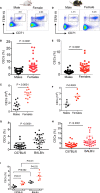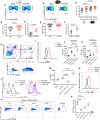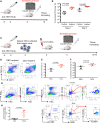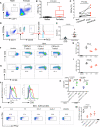Sex Matters: Physiological Abundance of Immuno-Regulatory CD71+ Erythroid Cells Impair Immunity in Females
- PMID: 34367164
- PMCID: PMC8334724
- DOI: 10.3389/fimmu.2021.705197
Sex Matters: Physiological Abundance of Immuno-Regulatory CD71+ Erythroid Cells Impair Immunity in Females
Abstract
Mature erythrocytes are the major metabolic regulators by transporting oxygen throughout the body. However, their precursors and progenitors defined as CD71+ Erythroid Cells (CECs) exhibit a wide range of immunomodulatory properties. Here, we uncover pronounced sexual dimorphism in CECs. We found female but not male mice, both BALB/c and C57BL/6, and human females were enriched with CECs. CECs, mainly their progenitors defined as CD45+CECs expressed higher levels of reactive oxygen species (ROS), PDL-1, VISTA, Arginase II and Arginase I compared to their CD45- counterparts. Consequently, CECs by the depletion of L-arginine suppress T cell activation and proliferation. Expansion of CECs in anemic mice and also post-menstrual cycle in women can result in L-arginine depletion in different microenvironments in vivo (e.g. spleen) resulting in T cell suppression. As proof of concept, we found that anemic female mice and mice adoptively transferred with CECs from anemic mice became more susceptible to Bordetella pertussis infection. These observations highlight the role of sex and anemia-mediated immune suppression in females. Notably, enriched CD45+CECs may explain their higher immunosuppressive properties in female BALB/c mice. Finally, we observed significantly more splenic central macrophages in female mice, which can explain greater extramedullary erythropoiesis and subsequently abundance of CECs in the periphery. Thus, sex-specific differences frequency in the frequency of CECs might be imprinted by differential erythropoiesis niches and hormone-dependent manner.
Keywords: CD71+ erythroid cells; anemia and immunity; anemia and infection; females; immune system and sex.
Copyright © 2021 Mashhouri, Koleva, Huynh, Okoye, Shahbaz and Elahi.
Conflict of interest statement
The authors declare that the research was conducted in the absence of any commercial or financial relationships that could be construed as a potential conflict of interest.
Figures





Similar articles
-
Galectin-3 regulates erythropoiesis and enhances the immunoregulatory properties of CD71+ erythroid cells across developmental stages.J Immunol. 2025 Jun 1;214(6):1202-1218. doi: 10.1093/jimmun/vkaf020. J Immunol. 2025. PMID: 40119673 Free PMC article.
-
Immunoregulation role of the erythroid cells.Front Immunol. 2024 Oct 15;15:1466669. doi: 10.3389/fimmu.2024.1466669. eCollection 2024. Front Immunol. 2024. PMID: 39474425 Free PMC article. Review.
-
Potent but transient immunosuppression of T-cells is a general feature of CD71+ erythroid cells.Commun Biol. 2021 Dec 10;4(1):1384. doi: 10.1038/s42003-021-02914-4. Commun Biol. 2021. PMID: 34893694 Free PMC article.
-
CD71+ Erythroid Cells in Human Neonates Exhibit Immunosuppressive Properties and Compromise Immune Response Against Systemic Infection in Neonatal Mice.Front Immunol. 2020 Nov 24;11:597433. doi: 10.3389/fimmu.2020.597433. eCollection 2020. Front Immunol. 2020. PMID: 33329589 Free PMC article.
-
The role of CD71+ erythroid cells in the regulation of the immune response.Pharmacol Ther. 2021 Dec;228:107927. doi: 10.1016/j.pharmthera.2021.107927. Epub 2021 Jun 24. Pharmacol Ther. 2021. PMID: 34171326 Review.
Cited by
-
Galectin-3 regulates erythropoiesis and enhances the immunoregulatory properties of CD71+ erythroid cells across developmental stages.J Immunol. 2025 Jun 1;214(6):1202-1218. doi: 10.1093/jimmun/vkaf020. J Immunol. 2025. PMID: 40119673 Free PMC article.
-
CD71 + erythroid cells promote intestinal symbiotic microbial communities in pregnancy and neonatal period.Microbiome. 2024 Jul 30;12(1):142. doi: 10.1186/s40168-024-01859-0. Microbiome. 2024. PMID: 39080725 Free PMC article.
-
Immunoregulation role of the erythroid cells.Front Immunol. 2024 Oct 15;15:1466669. doi: 10.3389/fimmu.2024.1466669. eCollection 2024. Front Immunol. 2024. PMID: 39474425 Free PMC article. Review.
-
Murine Bone Marrow Erythroid Cells Have Two Branches of Differentiation Defined by the Presence of CD45 and a Different Immune Transcriptome Than Fetal Liver Erythroid Cells.Int J Mol Sci. 2023 Oct 30;24(21):15752. doi: 10.3390/ijms242115752. Int J Mol Sci. 2023. PMID: 37958735 Free PMC article.
-
Hematopoietic responses to SARS-CoV-2 infection.Cell Mol Life Sci. 2022 Mar 13;79(3):187. doi: 10.1007/s00018-022-04220-6. Cell Mol Life Sci. 2022. PMID: 35284964 Free PMC article. Review.
References
Publication types
MeSH terms
Substances
Grants and funding
LinkOut - more resources
Full Text Sources
Research Materials
Miscellaneous

